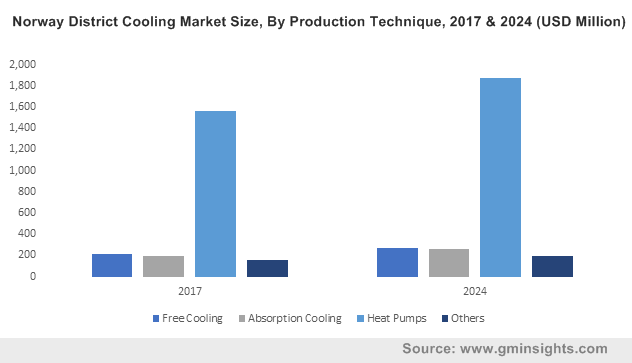European district cooling market to be driven by acquisition bids and a robust regulatory framework, industry share to exceed USD 40 billion by 2024
Publisher : Fractovia | Published Date : April 2018Request Sample
Owing to the rising inclination toward adopting sustainable technologies coupled with stringent regulatory measures, the European district cooling market has been witnessing a marked increase in its remuneration portfolio. The increasing levels of GHG emissions have led to extreme climatic conditions with comparatively high temperatures across the Eastern and Central regions of Europe. Moreover, according to the European Environment Agency, the annual mean temperature across these terrains would observe a significant increase in the near future. As a consequence of these environmental alterations, the overall European district cooling industry would gain substantial acclaim in the forthcoming years.
Norway District Cooling Market Size, By Production Technique, 2017 & 2024 (USD Million)

Concurrently, the escalating requirement for space cooling across the region coupled with the various government-initiated programs to lower energy imports has boosted the European district cooling market size augmentation. Numerous initiatives such as European Union’s COM (2016) 52 final program proposes to significantly reduce GHG emissions emitted from residential and commercial establishments. The program further aims to decarbonize large business complexes which would consequentially impel the growth prospects of European district cooling industry.
Acquisition bids by upcoming players to mark a new shift in European district cooling market
Meanwhile, it has been observed that numerous upcoming players have been pouring in massive resources to acquire the business of established companies and strengthen their position in European district cooling market. Citing an instance of the same, NIBE Industrier has recently acquired Alfa Laval’s district cooling systems operations. Reportedly, the acquisition is likely to be consolidated into NIBE’s Climate Solutions business and would be concluded by mid-2018. The latest takeover has apparently augmented NIBE’s presence across France, Finland, Sweden, Russia, Slovakia, the Czech Republic, and the United Kingdom. Furthermore, NIBE has planned to resume selling products under the well-known cooling system brands such as Uranus and Cetetherm, which would assist the Sweden headquartered firm to enhance its operating margin in the immediate future.
Speaking of the competitive spectrum, the European district cooling market is ablaze with renowned firms including the likes of Wien Energi, Engie, Ramboll, Logstor, Fortum, Veolia, Siemens, Helen, Vattenfall, Alfa Laval, and Goteborg Energi. These biggies, in accordance with the increasing investments toward research and development coupled with regionally changing sustainability trends, have been working persistently to unveil eco-friendly and energy efficient cooling systems.
How the regulatory structure being formulated by European Union would assist the European district cooling market share expansion
In an attempt to enhance the share of sustainable energy across the continent’s electricity grids, the European Union had framed an ambitious target of providing at least 27% of the total energy consumption from renewable sources by the year 2030. Apparently, in order to put in place a dedicated framework to achieve the goal, in late 2016, the European Commission rolled out a comprehensive set of legislative measures under the aegis of ‘Clean Energy for All Europeans’ package. Reportedly, this package primarily aims to assist in successful implementation of the clean energy transition plans across all the nations of European Union.
Furthermore, the package has been incorporated into the updated versions of the Energy Efficiency Directive (EED) and the Energy Performance of Buildings Directive (EPBD). The subsequent operationalization of these directives would irrefutably impact the size and type of natural refrigerants being utilized in cooling equipment in the European district cooling market.
Driven by ease of handling, superior flexibility, high standard of maintenance, and the consistent upgradation of the existing cooling systems, the European district cooling industry is slated to establish itself as one of major business verticals of sustainable and smart technologies industry. In tandem with the shifting focus toward product customization and a favorable regulatory structure, European district cooling industry is likely to surpass a remuneration portfolio of USD 40 billion by 2024, as per reliable estimates.